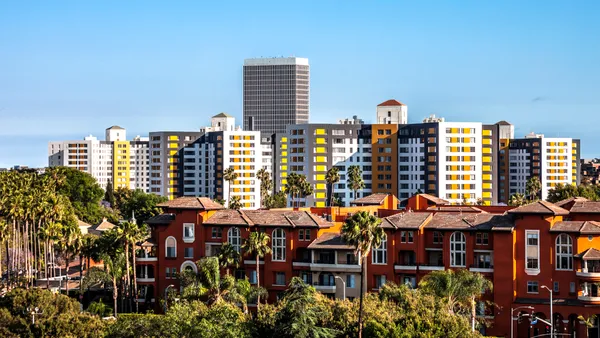The national average multifamily rent fell by $3 from August to September to $1,750, according to Yardi Matrix’s latest National Multifamily Report. Year-over-year rent growth was unchanged from the previous month at 0.9%.
Out of the top 30 metros tracked by Yardi Matrix, rent growth was positive in eight out of the top 10 markets with the least supply growth, with negative growth in eight out of 10 markets with the most supply growth. Gateway metros in the East and secondary Midwest markets remained at the top, led by New York City at 5.4%. The Sun Belt has shown the deepest negative rent growth, with Austin, Texas, at -4.9%, Raleigh, North Carolina, at -3.1% and Phoenix at -2.4%.
| Market | YOY rent growth, September 2024 | YOY rent growth, August 2024 | Difference |
|---|---|---|---|
| New York City | 5.4% | 4.8% | 0.6 |
| Kansas City, Missouri | 4.2% | 4.1% | 0.1 |
| Boston | 3.4% | 2.9% | 0.5 |
| Indianapolis | 3.3% | 3.0% | 0.3 |
| Washington, D.C. | 3.1% | 3.4% | -0.3 |
| Detroit | 3.0% | 2.0% | 1 |
| Columbus, Ohio | 2.8% | 2.9% | -0.1 |
| New Jersey | 2.8% | 2.9% | -0.1 |
| Chicago | 2.4% | 2.1% | 0.3 |
| Philadelphia | 1.9% | 1.7% | 0.2 |
SOURCE: Yardi Matrix
Single-family rental rates fell $3 from August to September, down to $2,167. YOY rent growth fell 30 basis points to 0.6%, while occupancy was unchanged at 95.3% in August.
The Federal Reserve cut interest rates on Sept. 18, and further cuts are anticipated in the future. The economy’s performance is providing tailwinds for the industry, with 3.0% GDP growth in the second quarter of the year and 254,000 new jobs in September.
Post-pandemic absorption
Strong economic growth has been a driver of multifamily demand, with over 300,000 new apartment units absorbed in the first quarter of 2024 — and more than 1.7 million since the start of the COVID-19 pandemic lockdowns in the first quarter of 2020. Absorption has been strongest in the Sun Belt and Mountain West regions, although rents have flattened in some metros in these areas due to high supply growth and are expected to remain weak through 2025.
Out of 132 major markets covered by Yardi, more than half — 68 — absorbed at least 10% of their current stock in the period between March 2020 and August 2024. No market saw negative absorption, while only 10 experienced less than 4%. Dallas led the major markets in absorption at 108,000 during this time, followed by Houston at 71,000 and Washington, D.C., at 60,000.
“The pandemic created a migration in 2021 from large coastal centers to suburbs and less expensive areas, especially the Sun Belt and Mountain West,” the report reads. “Absorption remains high due to the strong job market, an immigration boom and the ongoing effects of work from home. Although some factors such as economic growth and immigration are expected to weaken, demand is unlikely to drop too much.”











